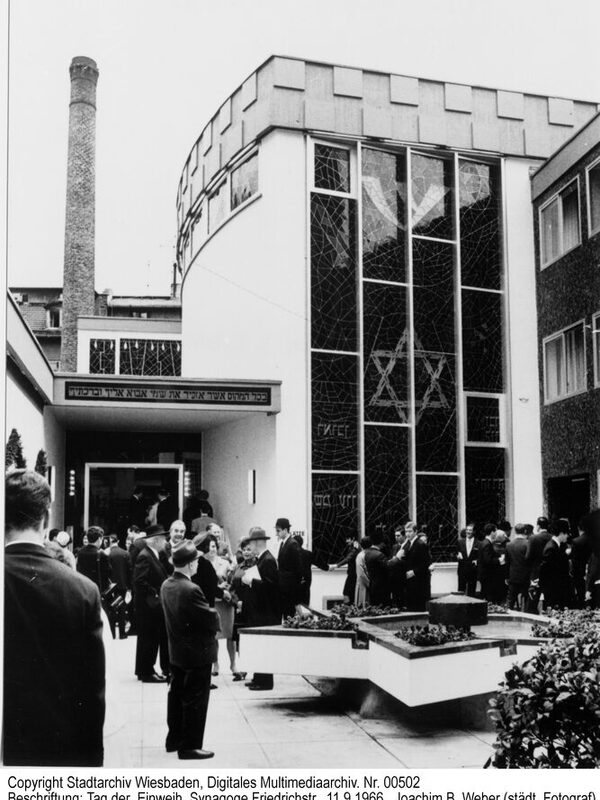Jewish community of Wiesbaden (after 1945)
Jews began arriving in Wiesbaden again immediately after the end of National Socialist rule. Most of them were Polish Jews who had survived the Shoah in the camps and were waiting to emigrate to the USA, Palestine or Australia. Former Jewish fellow citizens also returned, such as Claire Guthmann and her daughter Charlotte, who came back from Theresienstadt concentration camp in May 1945. In early summer, Ludwig Fried and his daughter Anita (married name Lippert), Erich and Günther Kahn with their father Max, Marianne Kahn and her father Adolf, Heinz Liechtenstein and his 12-year-old son Rolf arrived in Wiesbaden. Eva Gerstle-Wertheimer, who had survived several concentration camps and a death march, arrived in June.
On July 21, 1945, Claire Guthmann applied for the "re-establishment" of the congregation, which took place by July 28. The community office was located in the former Jewish old people's home at Geisbergstraße 24, together with an office of the Jewish aid organizations. Rabbi Dr. Leopold Neuhaus in Frankfurt am Main was officially responsible for the religious care of the community. The half-destroyed synagogue in Friedrichstraße was rebuilt with the help of the US Army. From January 1946, a committee of nine led the community. It was headed by Dr. Leon Frim, a lawyer from Lemberg who had survived the Auschwitz and Buchenwald concentration camps. Martin Hornung acted as permanent secretary, Jacob David "Jack" Matzner as finance officer, Dr. Baruch Laufer as officer for care matters and restitution issues and Chaijim Hecht as rabbi. They were joined by Mr. Sax, Mr. Ehrhaft and Mr. Isaaksohn as well as Mrs. Claire Guthmann. By October 1946, the community had grown to 226 members. On Hanukkah 5707 (December 22, 1946), the former synagogue at Friedrichstraße 33 was finally handed over for its intended purpose in a ceremony attended by the Hessian military governor James R. Newman. A number of ritual objects, which had been secured by the former community servant Hubert Maurer before the destruction of the place of worship, and the only surviving Torah scroll were ceremoniously handed over.
In the 1960s and 1970s, German Jews returned from emigration in South America - mainly from Chile - and families from Eastern Bloc countries, including Romania, moved in. As a result, different languages always predominated in the community: Polish with Yiddish, the German of the returnees, often paired with Spanish, increasingly also Romanian and Hungarian and the American English of the Jewish soldiers from the US armed forces who came to services in Friedrichstrasse. On Rosh HaShanah (11.09.1966), State Rabbi Dr. Isaak Emil Lichtigfeld was able to consecrate the new synagogue in Friedrichstraße in place of the old one. In 1990, Jews began to immigrate from the Soviet Union.
Today (as of 2015), the Jewish community is the third largest in Hesse with around 780 members. The Jewish community is a public corporation and is a member of the State Association of Jewish Communities in Hesse. In 2008, it concluded a contract with the city of Wiesbaden in which the mutual responsibility and the good relationship between the citizens of Wiesbaden and their Jewish fellow citizens were set out in writing.
Literature
It began on Hanukkah. Wiesbaden - A community thanks to American help. In: Jüdische Allgemeine from November 2006.
Müller-Gerbes, Heidi: Jewish community celebrates a double anniversary. In: FAZ 8.11.2006.
AT HOME? Newspaper for the exhibition on the occasion of the 60th anniversary of the reopening of the Jewish Community of Wiesbaden and the 40th anniversary of the inauguration of the synagogue in Friedrichstraße. Special supplement of the Wiesbadener Kurier and the Wiesbadener Tagblatt of 10.11.2006.
